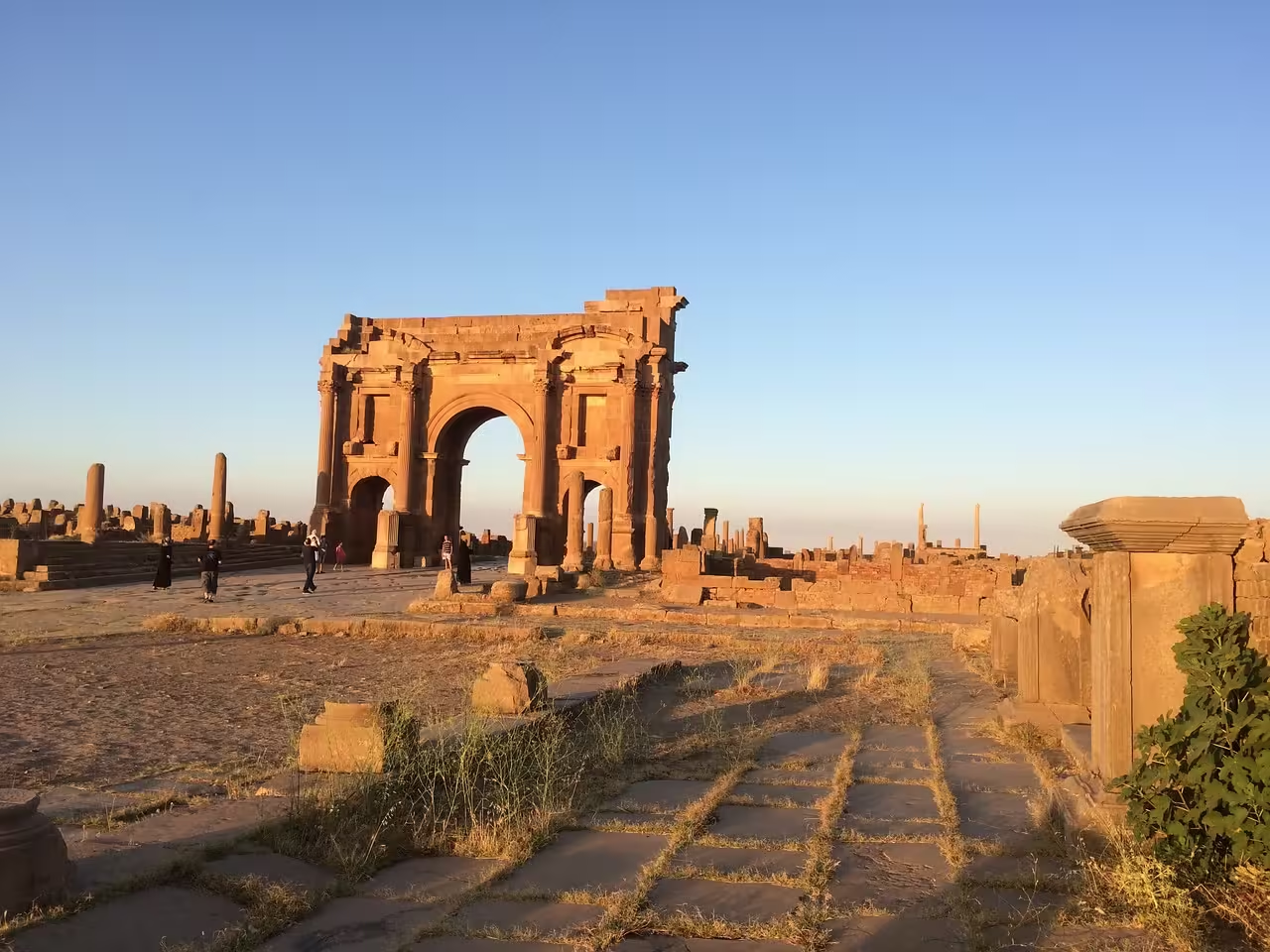Timgad in Algeria

Explore Timgad in Algeria
Timgad in Algeria: A Roman Legacy Preserved in Stone
Timgad in Algeria, often referred to as the “Pompeii of Africa,” remains one of the most remarkable Roman archaeological sites in North Africa. Nestled in the Aurès Mountains near Batna, this ancient city was founded around 100 AD by Emperor Trajan. It served as a settlement for Roman army veterans and stands today as a testament to Roman urban planning, architecture, and cultural influence.
Designated a UNESCO World Heritage Site in 1982, Timgad continues to attract visitors from around the world. Its well-preserved ruins offer a rare opportunity to explore the daily life, civic structure, and artistic achievements of a Roman city that once thrived far from the empire’s centre.
A City Built on Order and Design
Timgad’s layout reflects the Roman emphasis on structure and organisation. Built as a reward for military service, the city provided land and resources to retired soldiers. Its grid system, based on the cardo and decumanus, two main streets intersecting at right angles, created square blocks that defined the city’s structure.
This design allowed for efficient movement and clear zoning of public and private spaces. The city’s layout also symbolised Roman values, with order and symmetry playing central roles in urban development. Walking through Timgad today, visitors can still trace the original street plan and appreciate the foresight behind its construction.
Public buildings, temples, and baths remain scattered across the site, offering insights into how Roman cities functioned in distant provinces. These structures reveal the adaptability of Roman engineering and the importance placed on civic life, even in remote locations.
The Forum at the Heart of Civic Life
At the centre of Timgad lies the forum, a large open square that served as the hub of political, social, and administrative activity. Surrounded by columns and ruins, the forum invites visitors to imagine the vibrant discussions and gatherings that once filled the space.
Key buildings within the forum include the curia, or town hall, and a basilica used for judicial and administrative purposes. Though these structures now stand in ruins, they reflect the Roman commitment to civic engagement and community governance.
The forum’s design encouraged interaction and participation, reinforcing the idea that public life was essential to Roman identity. Exploring this area offers a glimpse into the values that shaped Roman society and how they were expressed in architecture and urban planning.
The Arch of Trajan
One of Timgad’s most iconic landmarks is the Arch of Trajan, a triumphal arch that marked the city’s entrance. Positioned at the end of the decumanus, this sandstone structure honours Emperor Trajan and celebrates the achievements of the Roman Empire.
Detailed reliefs and inscriptions adorn the arch, showcasing the artistry and craftsmanship of Roman builders. Its preservation makes it one of the most photographed features of the site, drawing admiration for both its scale and elegance.
Standing before the arch, visitors can reflect on the power and reach of Rome, as well as the legacy it left behind in places like Timgad. The monument serves as a powerful reminder of the empire’s influence and the pride it took in commemorating its accomplishments.
The Theatre
Timgad’s large theatre, built into a hillside, could accommodate around 3,500 spectators. Its semicircular design enhanced acoustics, allowing performances and speeches to reach even those seated furthest from the stage.
Many original features remain intact, including stone seats, stairways, and the stage area. In ancient times, the theatre hosted a variety of events, from dramatic performances to public ceremonies. These gatherings fostered a sense of community and provided entertainment for residents.
Today, standing within the theatre offers a chance to connect with the cultural life of the city. The space reflects the Roman appreciation for the arts and their role in shaping public life. It also highlights the importance of shared experiences in building strong communities.
Temples and Spiritual Life
Religion played a central role in Roman society, and Timgad was no exception. The city housed several temples dedicated to Roman deities, including the Capitolium, which honoured Jupiter, Juno, and Minerva.
The remains of the Capitolium, with its towering columns and elevated platform, illustrate the significance of spiritual practice in daily life. Temples served not only as places of worship but also as venues for festivals and communal gatherings.
These structures helped forge a shared cultural identity and reinforced the values of Roman civilisation. Visiting the temples allows for reflection on the spiritual dimensions of ancient life and the ways in which belief systems shaped urban environments.
Public Baths
Roman baths were more than places for hygiene. They also functioned as social centres where people relaxed, met friends, and conducted business. Timgad’s public baths, adorned with mosaics and equipped with advanced heating systems, demonstrate the ingenuity of Roman engineering.
These facilities improved quality of life and promoted social cohesion. The baths offered a space where individuals from different backgrounds could interact, reinforcing the inclusive nature of Roman urban life.
Exploring the remains of the baths reveals the technical skill of Roman builders and the emphasis placed on comfort and community. Their design reflects a holistic approach to city living, where physical well being and social interaction were closely linked.
Everyday Life
Beyond its public monuments, Timgad included a network of private residences, shops, and artisan workshops. Archaeological discoveries have uncovered pottery, tools, and household items that shed light on the daily routines of its inhabitants.
Homes ranged from elaborate villas with decorative features to modest dwellings that housed ordinary citizens. These spaces reveal the diversity of life in the city and the ways in which people adapted to their environment.
Workshops and markets supported local economies and provided essential goods and services. The presence of these facilities highlights the self-sufficiency of the city and its role as a vibrant centre of commerce and craftsmanship.
A Window into Roman Expansion
Timgad provides a lens through which to view the expansion of Roman culture and governance. The city exemplifies how Rome established thriving urban centres far from its capital, integrating local landscapes into its broader imperial vision.
Its ruins speak to the adaptability and ambition of Roman planners, who brought order, infrastructure, and culture to distant regions. Timgad stands as a symbol of this reach and the enduring legacy of Roman civilisation.
For historians, archaeologists, and curious travellers, the site offers invaluable insights into the past. It invites exploration and reflection, encouraging visitors to consider the complexities of empire and the resilience of human creativity.
Visiting Timgad: A Journey Through Time
Exploring Timgad in Algeria is a deeply enriching experience. The site’s layout, monuments, and artefacts create a vivid picture of life in a Roman city. Walking its streets, visitors can connect with history in a tangible and meaningful way.
Guided tours enhance understanding by providing context and interpretation. These experiences allow for deeper engagement with the site and its stories. Whether admiring the Arch of Trajan, sitting in the theatre, or wandering through the forum, each moment offers a chance to step back in time.
Timgad’s location in the Aurès Mountains adds to its appeal, combining historical exploration with natural beauty. The surrounding landscape provides a serene backdrop for reflection and discovery.
